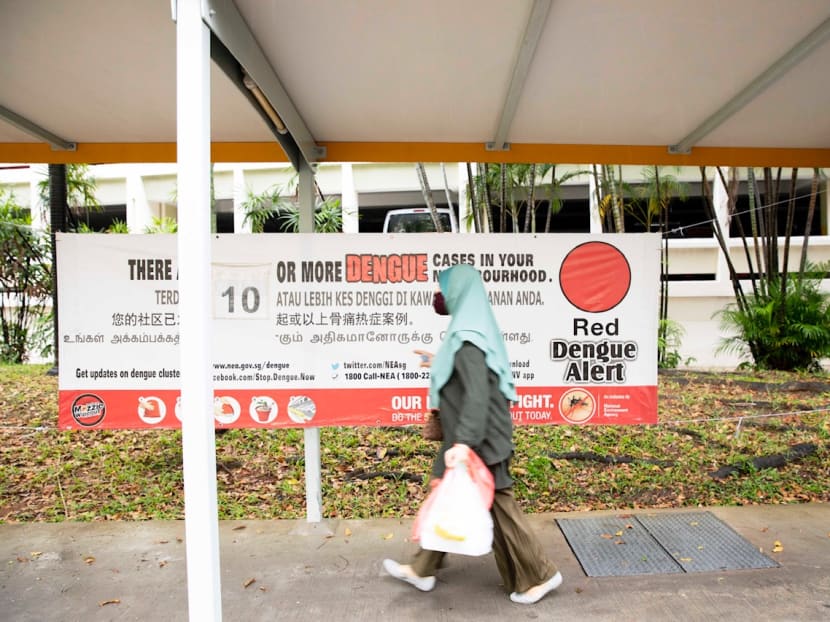Singapore's dengue cases lower than in 2020 but Aedes mosquito population is increasing: NEA
SINGAPORE — Dengue cases in Singapore are lower than a year ago, but the National Environment Agency (NEA) has warned of a jump in the Aedes aegypti mosquito population and that two serotypes of dengue are on the rise.

A pedestrian walking along a sheltered pavement with a red dengue alert banner near Block 608A, Woodlands Ring Road, Singapore on April 21, 2021.
- The number of dengue cases in Singapore is lower this year than 2020, when a major outbreak of the disease struck
- However, NEA has warned that the population of the mosquito which carries dengue is increasing
- The agency urged Singaporeans to take action to prevent mosquito breeding or risk a rise in dengue cases
SINGAPORE — Dengue cases in Singapore are lower than a year ago, but the National Environment Agency (NEA) has warned of a jump in the Aedes aegypti mosquito population and that two serotypes of dengue are on the rise.
The two serotypes, which have the same characteristics within the group of virus, have not been dominant in about 30 years.
More than 2,700 dengue cases have been reported since the start of the year, NEA said in a statement on Tuesday (June 1).
Although weekly dengue cases have been lower than during the same period last year, when Singapore experienced a “historic outbreak”, the numbers this year are still higher than those in 2017 and 2018, the agency noted.
It also detected a 30 per cent increase in the population of the Aedes mosquito — the primary carrier of the dengue virus — in April as compared with January.
With more people staying at home during Singapore’s Phase Two (heightened alert) period, NEA said that this could mean more biting opportunities for the mosquito, resulting in a potentially higher risk of transmission.
“If left unchecked, the current high Aedes aegypti mosquito population, coupled with the circulation of previously uncommon dengue virus serotypes and a sizable proportion of people staying in and working from home, would add to the dengue risk this year.”
There are now 22 active dengue clusters in Singapore, NEA added.
MORE PEOPLE SUSCEPTIBLE
Dengue cases due to the less common dengue virus serotypes — DENV-3 and DENV-4 — account for more than half the serotypes sampled since February.
NEA said that the DENV-3 was last dominant here 30 years ago and the occurrence of DENV-4 has been consistently low.
“Thus the population immunity for DENV-3 and DENV-4 is low, and more people are susceptible to transmission of the virus,” it explained.
In addition, these warmer months of the year mean an increased risk of higher dengue transmission.
NEA said that it “expects an increasing number of dengue cases due to the accelerated breeding cycle and maturation of the Aedes mosquito vectors, as well as the shorter incubation period of the dengue virus.”
All operators and owners of premises are reminded to ensure that comprehensive vector control measures and good housekeeping are in place.
“NEA continues to conduct targeted inspections at areas with higher mosquito populations and has stepped-up operations at dengue clusters.”
To prevent mosquito breeding, NEA urged residents to do the following:
Break up hardened soil
Lift and empty flower pot plates
Overturn pails and wipe their rims
Change water in vases
Keep roof gutters clear and add insecticides with bacillus thuringiensis israelensis (Bti) usually available from pest control companies
EFFECT OF CIRCUIT BREAKER
Last August, a study was conducted by NEA and Saw Swee Hock School of Public Health at the National University of Singapore to examine the effect of the circuit breaker period on the number of reported dengue infections. This was in last April and May when Singapore had a partial lockdown and people had to stay home.
Results showed that, based on mathematical modelling, there were 50 per cent more infections during this period than expected.
Most of the excess infections were among working adults aged between 20 and 64, who would typically have been in their workplaces instead of in their homes.








